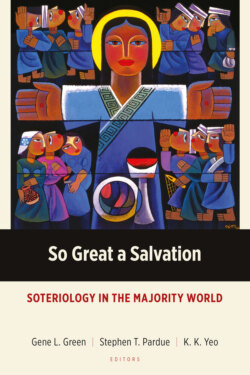Читать книгу So Great a Salvation - Группа авторов - Страница 25
На сайте Литреса книга снята с продажи.
Biblical Reform?
ОглавлениеSuch questions about traditional soteriologies and alternative possibilities probably inform the apocalyptic readings of Paul mentioned previously, and almost certainly elicit the aforementioned interest in biblical corpora beyond Pauline theology: Jesus in the Gospels bearing the healing kingdom of God in person; catholic epistles calling for moral transformation and addressing its cosmic context (which, incidentally, Paul addresses too!); the exodus and other Old Testament paradigms like the Jubilee fostering hope for liberation and justice; and the prophets denouncing the injustice, individualism, and idolatry of the covenant people’s soteriological status quo. These biblical resources—and theological resources stemming from existing Majority World interest in such scriptural teaching—are deep and wide.
The remainder of this soteriological overview can only hint at one modest suggestion concerning the new covenant and its context of the new creation. The basis of this suggestion lies in the significance of the new covenant for the traditional focus on personal salvation. Jeremiah 31:31–34, not least in its use by Hebrews (8:7–13), presents a twofold focus: forgiveness of sins and transforming knowledge of God—loosely but dogmatically put, justification and sanctification. Even contemporary readings of Paul, with their communal focus, recognize the importance of these concepts for creating God’s covenant people as a new humanity in Christ.
Simultaneously, given extensive recent concern over supersessionism,[33] the new covenant is important for keeping Christian soteriology anchored in the hopes of Israel’s Scriptures—resisting appeals to Jesus Christ that would replace Old Testament faith with a merely human revolutionary program or a misguided churchly one. Far too often, Jews have needed liberation from oppressive Christianity’s theological roots. So, however we construe the creation of a new humanity in Christ, Christians dare not lose the biblical and loving particularity of God’s covenant history with Israel.
The new covenant is biblically important, moreover, for theologically integrating divine initiative and human transformation. Atonement—initially and vitally involving forgiveness of sin—depends on what God alone does in self-giving love. The resulting sanctification of God’s people has both initial and ultimate dimensions that are divinely accomplished, plus an ongoing dimension that is divinely enabled. Yet that ongoing dimension, despite only being realized in the ultimate fullness of divine presence, is our very human calling: becoming holy as God is. These are not the only dimensions of new covenant saving hope, but they anchor such hope in loving divine initiative rather than human self-help—whether individual or communal or revolutionary or systemic. At the same time, the Old Testament prophets refuse to allow forgiven persons to wallow in idolatrous brokenness, as if continually calling on God with bloodstained hands. Judgment begins with the household of God, whose new covenant members must call on the Lord out of genuinely contrite hearts—not complacent appeals to a supposedly privileged position.
Admittedly, a comprehensive account of new covenant saving hope is impossible in this space. Yet, if the soteriological importance of that hope has been established, then we may turn briefly to its content. For that content the Isaianic new creation and new exodus passages, which shaped Jesus’s self-understanding and prominent New Testament themes, would surely deserve substantial attention. They indicate that Jesus’s presentation of the divine reign inaugurates the fulfillment of Jewish hopes regarding bodily healing, communal restoration, and creational shalom. The New Testament is replete with newness: Jesus called for new wineskins to hold the new covenant’s new teaching, new commandment, new name, new song, and so forth.[34]
In suggesting the Old Testament prophetic context of new creation for scriptural reform of the new covenant’s overly personal application, the remaining task is to highlight broader soteriological elements in Jeremiah 31. Verse 1 immediately sets the end of this saving hope in a communal context: God living with a restored, unified covenant people. As ensuing verses like verse 5 indicate, restoration will delight this people in the fruit of the land. In verse 6 they go to worship as a people, not just individuals. Verse 8 includes marginal persons in this joy: the blind, the lame, and pregnant women. No outdated social markers or ritual boundaries of cleanliness need keep anyone from joining in worship. In verse 9 the water of repentant tears gives way to physical streams and smooth paths. Radiant joy over creation’s good things embraces not just the land’s abundance but also animals in verse 12. The cosmic blessings of new covenant hope appear in the freedom with which the text uses physical imagery to convey holistic, even spiritual, flourishing. The restored joy in verse 13 and abundant provision in verse 14 affect every possible group in the community.
Verses 15–22 indicate that repentance is vital to the promised restoration and the new reality it brings. Colin Gunton helps to explain what is at stake: God’s saving renewal of creation—as full-orbed as it will be—must begin by addressing sinful humanity because our misdirected and aggregated wills are the crux of the problem.[35] We are those who turn God’s good creation into a source of idols, whose idolatry warps human cultures into systemic bearers of injustice and manifestations of broken relationships, and whose fearful and rapacious self-interest harms all that God lovingly made.
Back to Jeremiah 31, God shows particular interest in the disadvantaged according to verses 25–26, where weary laborers are promised refreshment. The fecundity and flourishing of people and animals in verses 27–28 are not inimical to the personal accountability in verses 29–30. For the new covenant in verses 31–34 makes people right with God and new on the inside, inaugurating the covenant community and creation’s full healing. God appeals to creation in verses 35–37 as the reassuring basis of promised restoration: As surely as God lovingly made and sustains all things, so God promises to make the people new. Whatever the debated ecclesiological and eschatological implications, hope of new covenant restoration for the covenant people takes physical form in a remade, ever sacred city of Jerusalem.
